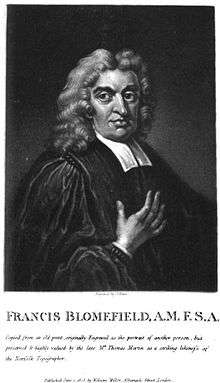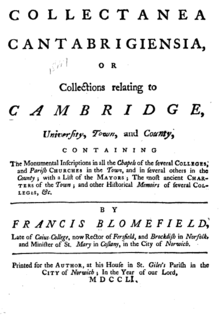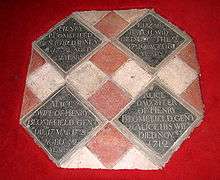Francis Blomefield
Francis Blomefield (23 July 1705 – 16 January 1752) was an English antiquary, who projected a county history of Norfolk. During his lifetime, he compiled and published detailed accounts of the city of Norwich, the Borough of Thetford and the southern hundreds of the county, but died before the whole work could be completed.

Biography
Francis Blomefield was born in the village of Fersfield in south Norfolk, the eldest son of yeoman farmers, Henry and Alice Blomefield. He was educated at Diss and Thetford Grammar Schools. In April 1724, he was admitted to Caius College, Cambridge, where he graduated BA in 1727 and MA in 1728.[1] On leaving university in 1727, he was ordained a priest, appointed Rector of Hargham in 1729, and shortly afterwards Rector of Fersfield, his father's family living. On 1 September 1732, he married Mary Womack, the daughter of a former rector of Fersfield. They had three daughters, two of whom survived him.

As a boy, Blomefield began recording monumental inscriptions from churches he visited in Norfolk, Suffolk and later Cambridgeshire. Whilst at college, he also kept genealogical and heraldic notes relating to local families. Soon after leaving university, he was collecting materials for an account of the antiquities of Cambridgeshire, but in 1732, this project was deferred when he was given access to Peter Le Neve's huge collection of materials for the history of Norfolk, by Le Neve's executor "Honest Tom" Martin. In July 1733, Blomefield published his proposals for publishing An Essay towards a Topographical History of Norfolk in parts. Soon afterwards, while collecting further information for his history, he discovered some of the famous Paston Letters. By 1736, he was ready to begin putting the results of his researches into type, assisted by his friend Charles Parkin, Rector of Oxborough. At the end of 1739, the first volume of Blomefield’s History of Norfolk was completed. It was printed at the author's own press at Fersfield, acquired specially for the purpose. The second volume, consisting of a detailed history of Norwich, was begun in 1741 and completed by 1745. In 1751, Blomefield published his Cambridgeshire notes as a single volume entitled Collectanea Cantabrigiensia. He was two-thirds through his third volume, but had only covered about 40 per cent of the county when he contracted smallpox on a visit to London, and died in Fersfield in January 1752.
In 1871, clergyman and naturalist Leonard Jenyns inherited the property of his distant cousin Francis Blomefield, which was worth more than £7000 and came with 140 acres near Diss, Norfolk. As a condition of the inheritance Jenyns changed his name to Blomefield by royal licence.
Completion of the History of Norfolk
The topographical history of the remaining areas of Norfolk was subsequently completed by Blomefield’s friend, the Rev Charles Parkin, between 1753 and 1765 (albeit in a far less detailed and accurate manner than Blomefield had managed). The remaining sheets of volume 3 and two further folio volumes were published at King's Lynn between 1769 and 1775. The entire work was subsequently reprinted in eleven quarto volumes in London in 1805–1810.
Assessment
Blomefield's Norfolk was both detailed and largely reliable and comparable with the best county histories of the period. There is little doubt that in compiling his book Blomefield had frequent recourse to the existing historical collections of Peter Le Neve, John Kirkpatrick of Norwich and Tanner, his own work being to some extent one of expansion and addition, despite some extensive collections of his own.
Notes
- "Blomefield, Francis (BLMT724F)". A Cambridge Alumni Database. University of Cambridge.
References
- Stoker, David (2004). "Blomefield, Francis (1705–1752)". Oxford Dictionary of National Biography. Oxford University Press. Retrieved 17 June 2007.
- Attribution

External links
| Wikisource has original works written by or about: Francis Blomefield |
- Rye, Walter (1886). . Dictionary of National Biography. 5. pp. 226–228.
- Blomefield's History of Norfolk at Wikisource
- Blomefield's History of Norfolk[1]
- Works by or about Francis Blomefield in libraries (WorldCat catalog)
